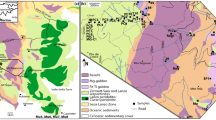Abstract
Upper mantle xenoliths from Wikieup, AZ, provide abundant evidence for magmatic modification of the uppermost mantle beneath the Transition Zone between the Colorado Plateau and the southern Basin and Range province. Upper mantle lithologies in this xenolith suite are represented by spinel peridotite, wehrlite, plagioclase peridotite, and Al-augite group pyroxenites. Isotopic data for these xenoliths yield relatively uniform values and suggest a common petrogenesis. Al-augite-bearing gabbro and pyroxenite xenoliths from this locality are interpreted to have formed by crystal fractionation processes from parent alkali basalts similar to the Wikieup host basalt. Mineral and whole rock compositions show consistent trends of increasing incompatible element contents (Fe, Al, Ca, Na, K, LIL, and LREE), and decreasing compatible element contents (Mg, Cr, Ni) from spinel peridotite to wehrlite to plagioclase peridotite to the host basalt composition. These compositional trends are interpreted as resulting from varying degrees of magma-mantle wall rock interaction as ascending mafic magmas infiltrated upper mantle peridotite. Small degrees of melt infiltration resulted in slightly modified spinel peridotite compositions while moderate degrees metasomatized spinel peridotite to wehrlite, and the highest degrees metasomatized it to plagioclase peridotite. Whole rock compositions and clinopyroxene, plagioclase, and whole rock isotopic data suggest that the infiltrating magmas were the same as those from which the gabbros and pyroxenites crystallized, and that they were alkalic in composition, similar to the Wikieup host alkali olivine basalts. Relatively uniform 143Nd/144Nd for the mineral separates and whole rocks in spite of the significantly wide range in their 147Sm/144Nd (0.71–0.23 in clinopyroxene) suggests that the Wikieup xenoliths including gabbro, pyroxenite, peridotite, wehrlite, and plagioclase peridotite, are all relatively young rocks formed or metasomatized by a relatively recent magmatic episode.
Similar content being viewed by others
Author information
Authors and Affiliations
Additional information
Received: 21 May 1996 / Accepted: 23 December 1996
Rights and permissions
About this article
Cite this article
McGuire, A., Mukasa, S. Magmatic modification of the uppermost mantle beneath the Basin and Range to Colorado Plateau Transition Zone; Evidence from xenoliths, Wikieup, Arizona. Contrib Mineral Petrol 128, 52–65 (1997). https://doi.org/10.1007/s004100050293
Issue Date:
DOI: https://doi.org/10.1007/s004100050293




